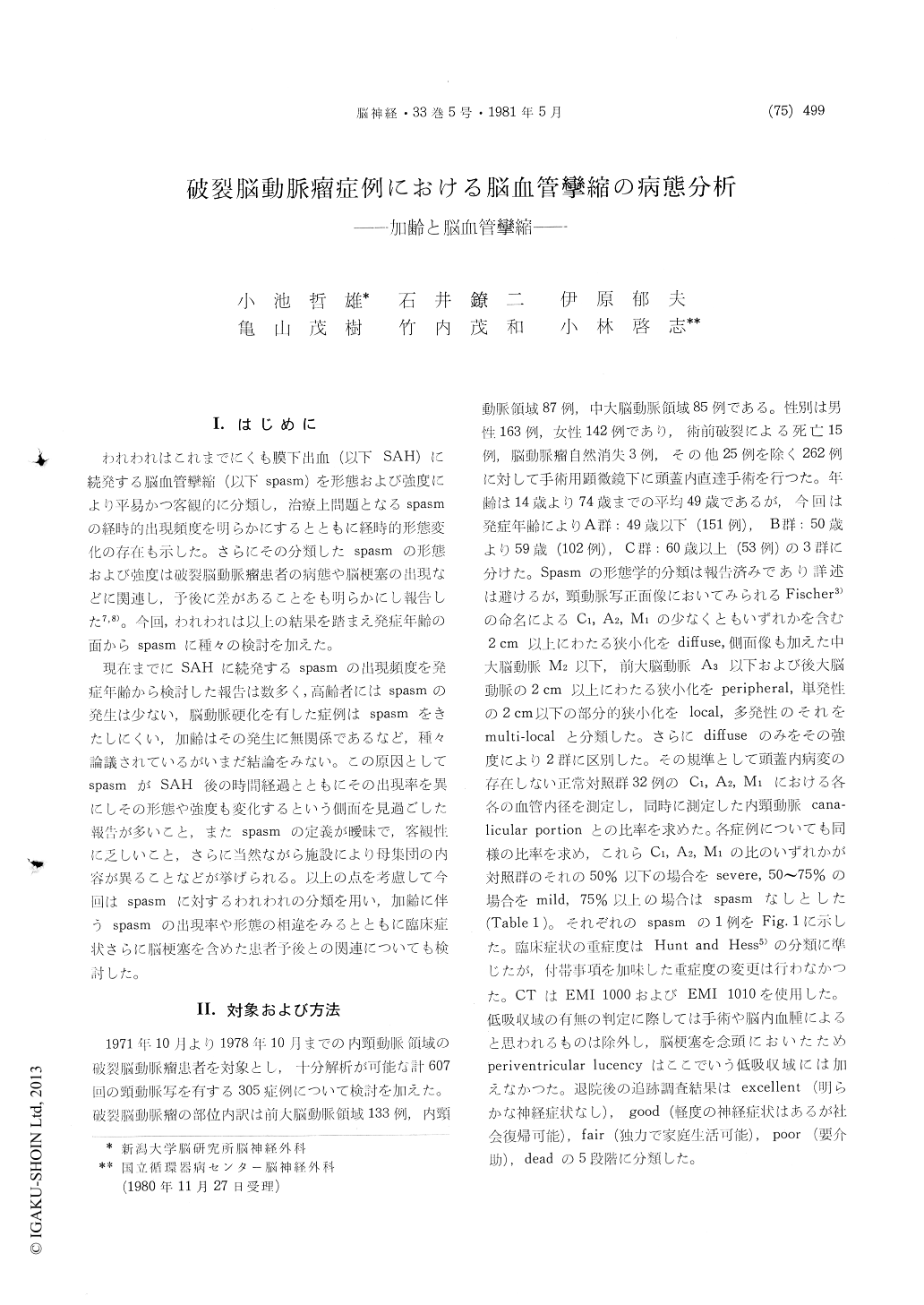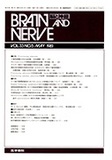Japanese
English
- 有料閲覧
- Abstract 文献概要
- 1ページ目 Look Inside
I.はじめに われわれはこれまでにくも膜下出血(以下SAH)に続発する脳血管攣縮(以下spasm)を形態および強度により平易かつ客観的に分類し,治療上問題となるspasmの経時的出現頻度を明らかにするとともに経時的形態変化の存在も示した。さらにその分類したspasmの形態および強度は破裂脳動脈瘤患者の病態や脳梗塞の出現などに関連し,予後に差があることをも明らかにし報告した7,8)。今回,われわれは以上の結果を踏まえ発症年齢の面からspasmに種々の検討を加えた。
現在までにSAHに続発するspasmの出現頻度を発症年齢から検討した報告は数多く,高齢者にはspasmの発生は少ない,脳動脈硬化を有した症例はspasmをきたしにくい,加齢はその発生に無関係であるなど,種々論議されているがいまだ結論をみない。この原因としてspasmがSAH後の時間経過とともにその出現率を異にしその形態や強度も変化するという側面を見過ごした報告が多いこと,またspasmの定義が曖昧で,客観性に乏しいこと,さらに当然ながら施設により母集団の内容が異ることなどが挙げられる。以上の点を考慮して今回はspasmに対するわれわれの分類を用い,加齢に伴うspasmの出現率や形態の相違をみるとともに臨床症状さらに脳梗塞を含めた患者予後との関連についても検討した。
Three hundred and five patients with rupturedintracranial aneurysms were analized to investigate the incidence and the type of vasospasm in refer-ence to the age. Furthermore, the effect of vasospasm was disclosed upon clinical states, the development of cerebral infarction and follow-up results as related to the age. The patients were classified into three groups: A—younger than 50 years, B—from 50 to 59 years, C—over 60 years. The extent of vasospasms was classified into four types: diffuse (narrowing over 2 cm in length in at least one of the C1, A2 and M1 portions), pe-ripheral (narrowing over 2cm in length in the distal portions), multi-local (multiple localized narrowing), local (single localized narrowing). The diffuse type of vasospasm was further divided into two grades of severerity: diffuse severe (reduction of the caliber by more than 50%) and diffuse mild (reduction of the caliber by 25 to 50%). As an indicator of objective estimation of vasospasms, the ratio of the diameter of the arteries at the C1, A2 and M1 portions to that of the canalicular portion of ICA was calculated from 32 normal angiograms (A-P projections).
The results were as follows. 1) The time course of the incidence of vasospasms was almost same in the three groups. Vasospasms were seen in only exceptioal cases within 3 days after subarachnoid hemorrhage. The incidence of vasospasms increased as the time passed, reached its peak between 8th and 15th day, and then decreased gradually. Only few cases showed vasospasm over 50 days after subarachnoid hemorrhage. 2) The incidence of vasospasms 4 to 20 days after subarachnoid hemor-rhage were A: 68.7%, B: 74.2%, and C: 50%, respectively. The difference between C group and other groups was statically significent. 3) Most of the vasospasms seen 4 to 20 days after subara-chnoid hemorrage were of diffuse type in A and B groups, while only half of the vasospasm belonged to diffuse type in C group. 4) Diffuse severe and peripheral type of vasospasm had serious effect on the clinical state and outcome of the patients in C groups, while the effect was not necessarily severe in A and B groups.

Copyright © 1981, Igaku-Shoin Ltd. All rights reserved.


